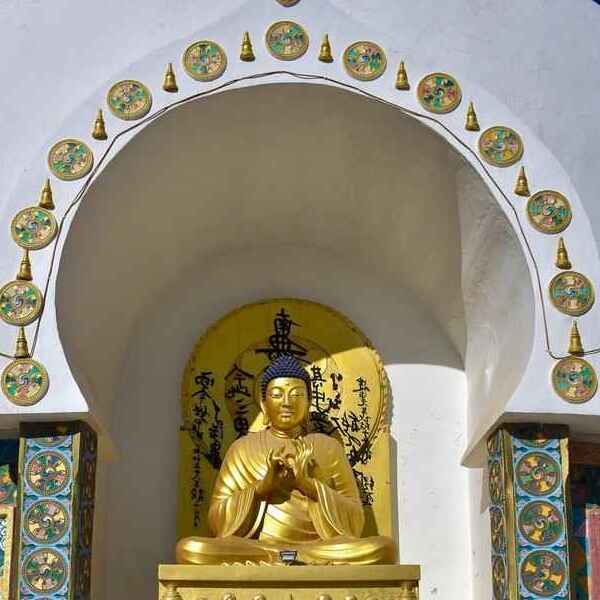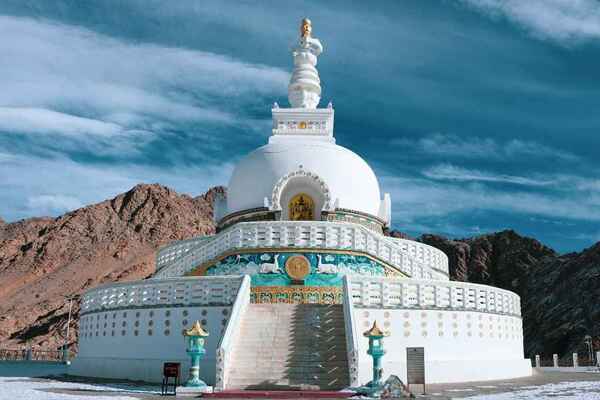
Shanti Stupa, a symbol of peace and enlightenment in the alluring region of Leh, Ladakh, is nestled in the lap of the Himalayas. This architectural wonder, perched on a hill, exudes a tranquil aura that both pilgrims and other tourists feel.
Shanti Stupa, created in 1991 through a partnership between Ladakhi monks and Japanese Buddhists, has significant historical significance. Its building was started to honor Buddhism’s 2,500-year history and to advance world peace. The stupa’s pure white exterior and elaborate carvings combine traditional Ladakhi and Japanese architectural elements stunningly, creating a spectacle that perfectly encapsulates the idea of variety in harmony.
Shanti Stupa is a spiritual retreat that offers guests a chance to find their inner selves against the stunning backdrop of Leh’s panoramic vistas. Beyond its impressive appearance, it fulfills this purpose. The stupa fosters an environment of peaceful reflection as the first rays of dawn reveal its contours, and the setting sun paints a golden color onto its surface. Join us as we explore Shanti Stupa to learn more about its fascinating history, stunning architecture, and the transforming journey it offers to everyone who travels to its serene heights.
The Shanti Stupa in Leh, Ladakh, is a tribute to the enduring values of harmony and peace. Its beginnings can be found in the latter decades of the 20th century when Japan and India—two nations with strong ties to Buddhism—joined forces to construct it.
Japanese Buddhist monk Bhikshu Gyomyo Nakamura laid the Shanti Stupa’s foundation in 1983 as part of the Peace Pagoda project. The mission’s goal was to advance world peace and spiritual awakening. When the stupa was eventually finished and dedicated in 1991, Buddhism had been around for 2,500 years.

Both religious and political motives drove the construction of the Shanti Stupa. It was intended to symbolize hope for world peace and as a place of worship and meditation. Indian antique stupa architecture and Japanese artistic aspects have affected the stupa’s design.
The opening of the Shanti Stupa was a historic occasion that drew thousands of worshippers, dignitaries, and spiritual leaders. Since its construction, the stupa has become a revered Buddhist pilgrimage site and a destination for tourists looking for spiritual tranquility and expansive vistas of the surrounding landscapes.
The Shanti Stupa is still a symbol of peace and cross-cultural harmony today. Its past is still entwined with the united resolve of nations and communities to foster compassion, understanding, and calmness in a world that frequently lacks these traits.
The Shanti Stupa’s apparent architectural fusion represents its spiritual importance and the joint efforts of the two cultures. A characteristic of Ladakhi design, the stupa’s white façade is covered with exquisite carvings and symbols that reflect the region’s long-standing artistry. This artistic decision honors the local culture and gives the stupa a sense of place in the landscape.
Japanese inclination
A closer inspection reveals modest Japanese elements in the stupa’s design. The design of Shanti Stupa smoothly incorporates the straight lines, symmetry, and minimalist components prevalent in Japanese architecture. The end product is a special fusion that cuts across cultural barriers and embodies the stupa’s symbol of universal peace.
Design Symbolism
The Shanti Stupa’s architecture is more than just beautiful; it is a blank canvas for symbolism and significance. The five tiers of the stupa reflect the Five Dhyani Buddhas, who each stand for a different facet of enlightenment. The dome’s design alludes to the supreme wisdom Buddhism aspires to achieve, while the central pillar stands for the triumph of good over evil. Visitors are encouraged to pause and think more deeply about each carved picture, color scheme, and arrangement.
Spiritual Ascension
Traveling to Shanti Stupa involves both a physical elevation and a spiritual ascension. The stupa’s architecture encourages reverence and tranquility while facilitating visitors’ introspection. The roughly 500 stairs that go to the stupa’s peak are climbed gradually, reflecting the spiritual journey and ending with a peaceful moment at the top.

A Contemporary Peace Symbol:
The architecture of Shanti Stupa embraces modernity while remaining firmly anchored in tradition. Electric lighting illuminates the stupa at night and casts a glow that can be seen for kilometers surrounding it. The stupa’s everlasting message of peace and harmony is further highlighted by the contrast between its antique design and modern utility.
A few important information when you are planning for a visit to Leh Palace.
The Stupa can be visited throughout the year, but in the summer months May and June. September and October are best.
Open all days from 8 00 AM to 8 00 PM. You can visit the place even up to 8:30 if weather permits.
The entry is FREE.
However, you can feel free to make donations which is used purely for maintenance.
The Stupa is located at approximately 11500 feet (3500 meters).
Approximately 5 km from the city center.
The stupa is around 5 kilometers from the city center and can be reached in the following ways.
You can choose from our two options when visiting Shanti Stupa. We advise you to include local locations like Leh Palace and Leh Market in your plan.
Recommended itinerary for travelers arriving in Leh by Srinagar Leh Route.
Remember to stay hydrated and take it easy, considering the altitude and the day’s activities.
Travellers arriving in Leh via flight or the Manali-Leh highway should follow this route.
Remember to stay hydrated and take it easy, considering the altitude and the day’s activities.